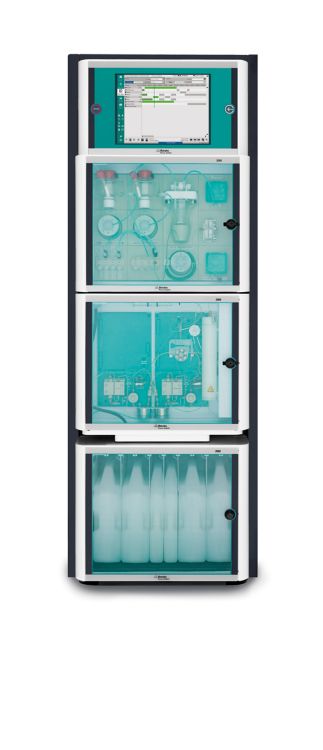In power plants, corrosion is the primary factor leading to costly and critical downtimes. Pressurized water reactors (PWR) are generally designed with a third water circuit in addition to the two found in other thermal power plants (e.g., boiling water reactors (BWRs) or coal-fired and geothermal power plants). In this so-called «primary circuit», the primary coolant water is pumped under high pressure to absorb heat generated by nuclear fission, further transferring this heat to the secondary circuit. The PWR ensures that radioactive materials remain contained and do not disperse to the secondary circuit and therefore potentially to the environment.
This additional water circuit entails some specific requirements regarding chemical analysis and monitoring. In the PWR, light water is used as primary coolant. Boron (as boric acid, H3BO3) readily absorbs neutrons and is added to the coolant to control reactivity. Additions of monoisotopic lithium hydroxide (LiOH) to the primary circuit assures a pH value greater than 7 to prevent corrosion. Lithium is therefore a critical parameter to monitor in PWRs.
Nickel is an important alloying metal that increases the corrosion resistance of steel. However, in the dissolved form, nickel promotes corrosion, making regular checks of the Ni2+ concentration necessary.
In addition, metals released by corrosion undergo nuclear reactions and thus increase radiation in the power plant. To limit corrosion of the materials and to prevent the formation of radioactive products, the water is often treated with depleted zinc oxide. The zinc concentration must be monitored as well to ensure radioactivity does not spread.

These cations and more can be determined down to the sub-μg/L range in a single analysis using ion chromatography. However, precise, reliable trace analysis requires the method to be automated as much as possible. Metrohm Process Analytics offers a complete solution for this task: the 2060 Ion Chromatograph (IC) Process Analyzer featuring combined Inline Preconcentration and Inline Matrix Elimination. With one injection, the 2060 IC Process Analyzer is able to measure numerous ionic compounds in aqueous media from ng/L to % concentrations. The analysis system is fed directly and continuously with samples via a bypass in the process. Automatic calibration guarantees excellent detection limits, a high reproducibility, and excellent recovery rates.
The 2060 IC Process Analyzer provides alarms if preset warning or intervention concentration limits are reached, helping to save costs by preventing irreparable damage due to corrosion. The 2060 IC Process Analyzer can monitor both anions and cations with a single ion chromatograph and two detector blocks, giving a comprehensive overview of the water circuit chemistry. The possibility to connect one analyzer to up to 20 sample streams means multiple areas within water-steam circuits in a power plant can be monitored by a single instrument. With a built-in eluent production module and optional PURELAB® flex 5/6 from ELGA® for pressureless ultrapure water, the 2060 IC Process Analyzer can be configured to run trace anion analyses autonomously for up to several weeks.
The analysis is carried out fully automatically using a combination of Inline Matrix Elimination (for the H3BO3) and Inline Neutralization (for the LiOH). Analyte detection is by conductivity.
- Inline eluent preparation ensures consistently stable baselines
- Protect valuable company assets (e.g. pipes, PWR, and turbines, which are prone to corrosion)
- Safe working environment and automated sampling)
- High precision analyses for a wide spectrum of analytes with multiple types of detectors
Related application notes
Copper, nickel, zinc, and common cations in the water-steam cycle of a boiling water reactor (BWR)
Zinc, nickel, calcium, and magnesium in borated water of a pressurized water reactor (PWR)
Lithium in borated water of a pressurized water reactor (PWR)
Online analysis of trace cations in power plant water matrices
Other related documents
 Share via email
Share via email
 Download PDF
Download PDF